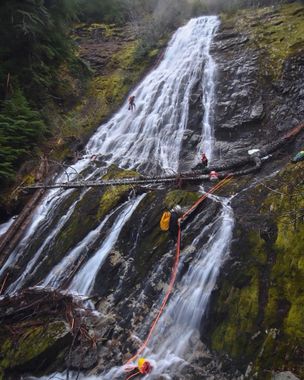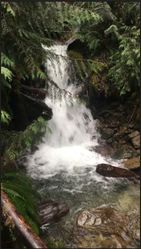Bishop Creek Canyoneering Canyoning Caving
|
| Rating: |
Log in to rateLog in to rateLog in to rateLog in to rateLog in to rate 2.3 (3 ratings) |
|

|
| |
Raps: No Shuttle:Required 5 min |
|---|
| Location: |
|
|---|
| |
|---|
| Condition Reports: |
(log in to submit report)
|
|---|
Weather: |
|
|---|
| Best season: |
Dec-Mar | winter | | spring | | summer | | fall |
|---|
| Dec | Jan | Feb | | Mar | Apr | May | | Jun | Jul | Aug | | Sep | Oct | Nov |
|
| Regions: |
|
46.4396, -121.6837https://ropewiki.com/images/1/1b/Bishop_Creek.kmltopo
GPS data automatically extracted from [], please visit their site for more detailed information.
Automatic GPS data extraction NOT allowed, please visit [] to download GPX.
Reference photos

13 Jan 2018:
Moderate-Low. A bit low, still fun but not very challenging (class C1- = a4-). Taken from where the water exits the culvert (near shuttle parking)
These reference pictures are used in the
Waterflow analysis to predict current conditions. More reference pictures will produce a more reliable prediction.
(log in to submit reference picture) | Welcome! Canyons in the Pacific Northwest can be different from those you might be used to. Be ready for unlinked bolts, retrievable traverse lines, and challenging aquatic environments. For more on local practices, and the best way to get started in the region, check out the WCC Safety page.
- Unlinked Bolts - groups should be comfortable rigging unlinked bolts, either temporarily linking them for all but the last person, or using a passive redundancy method. Most importantly, if you find two bolts side by side that are unlinked, do not add webbing to them. Linking bolts designed to be unlinked will likely cause damage during seasonal floods.
- Traverse Lines - many canyons are rigged to allow traverse line access to an exposed anchor station. This should be done using self-belay or team belay techniques. Do not leave fixed lines in the canyons.
- Challenging Environments - the highly aquatic nature of PNW canyons can surprise many. Cold temperatures, slippery rocks, loud waterfalls, and strong currents all lead to unexpected problems. Do not underestimate the need for strong team work and technical proficiency. Belays are frequently not possible. Unattended gear will sink or float away. Sliding and jumping is the cause of most major injuries, so it's critical to effectively communicating water depth & submerged hazards.
|
Introduction[edit]
Bishop Creek offers a mediocre experience for those willing to run canyons in the PNW Winter. The slot at the lower section is shallow and unimpressive and creek walking is slow and careful due to the broken rock fragments.
Approach[edit]
As of January 2018, the road to the drop in has been washed out.
Park the car at the washout and hike on the road for 2 miles. When the road makes a hairpin turn, proceed uphill offtrail making sure not to get cliffed out or you’ll miss the first series of drops.
Descent[edit]
The first four rappels are open cascade-like waterfalls. The canyon features a type of rock that flakes off in large sections. There are several loose flakes that were noticed while rappelling R4.
R1: 50'
R2: 20' DCR
R3: 60' DCL
R4: 150' DCR - webbing wrapped around tree root and limbs.
R5+: There are several (5-7) additional rappels ranging from 10-20'. There is an abundance of natural anchors and some rappels are directly in the flow of the water.
Red tape[edit]
Beta sites[edit]
Trip reports and media[edit]
Background[edit]
Bishop creek was first descended by Doug Hecker, Haruka Clay Lipscomb, Gilly Elor, Jake Huddleston, Brent Roth, Barry Specht, and Tiffanie Lin on January 13, 2018.

